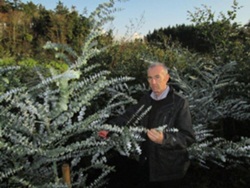
New varieties bring colour to the flower market: The market for cut flowers and foliage continues to expand. In the past year over four million stems of cut flower and foliage were locally grown. This is due to various factors including an increase in market demand for locally grown quality produce, increased yield and mild weather. The main cut flower and foliage crops grown locally include lilies, scented stocks, chrysanthemums, sweet william and eucalyptus. This year with a mild spring, good summer and mild autumn cut flower growers experienced a longer harvesting period.

Local flower growers continue to develop with a focus on an increasing range of cool season crops. A major part of CAFRE’s support to growers is the evaluation of new crops and varieties at Greenmount Campus. In the past year a number of new cut flower crops were grown to determine their suitability for Northern Ireland (NI) production, for example, sweet pea, dahlia, anemone and ornamental kale. Eucalyptus is the main filler used by florists in flower bouquets and designs. However, growers have been dependant on a few varieties and suggested that a wider range of varieties could be tried. The Eucalyptus Project involved evaluation of 20 varieties sourced from New Zealand and planted in 2011. Some of these new varieties are now at harvesting stage and are showing promise. There is an opportunity on 14 January 2015 for interested growers to see these new varieties and receive an update on the management techniques used to improve yield and stem quality. This event, which will take place at Greenmount Campus, will include a crop walk of the Eucalyptus Project and a talk by grower-florist Gill Hodgson, founder of Flowers from the Farm Network. For further details contact mark.finnegan@dardni.gov.uk or david.kerr@dardni.gov.uk or online www.dardni.gov.uk/cut-flowers.
The cut flower and foliage sector includes a wide range of growers who sell to various markets including supermarkets, florists and farmers markets. However, they work together sharing their experiences and knowledge through their network the Northern Ireland Flower and Foliage Association (www.niffa.co.uk).
Protecting horticultural crops against cold weather
Don’t let the unseasonably mild weather experienced in November make you complacent about protecting your horticultural crops this winter. Remember the winter of 2010 when NI experienced an overall average temperature of -0.6 centigrade which was the coldest December on record. These extreme sub-zero temperatures caused wide spread damage to commercial horticultural crops and nursery irrigation facilities. Plants in containers are more likely to suffer winter damage than field grown plants. The root system of container grown plants is above the ground and exposed to much lower temperatures than in the soil. Freezing damage occurs when ice crystals form within plant tissue and rupture the cells. Research has shown that roots can be killed on subjects such as Ilex (Holly) at -4 degrees centigrade. A lot of plants appeared to have survived the sub-zero temperatures but then collapsed when growth started the following spring. Desiccation or drying occurs because water uptake by the roots is exceeded by loss from the leaves and stems. This happens when the root ball is frozen and the air temperature begins to rise. The effect can be made worse by cold winds. As we did not experience cold winds in 2010 at the time of the low temperatures, frozen root damage did not show on many plants until growth restarted in spring.
The extent of winter damage can vary according to location of an individual nursery or farm and between regions. If you are a grower, minimise the risk of damage to your horticultural crops and equipment by:
- Using appropriate insulation and frost protection measures.
- Bringing plants under protected structures and using wind breaks.
- Covering plants with protective fleece materials.
- Careful watering of plants to avoid overwatering.
- Draining out irrigation systems and equipment before cold weather sets in.
- Setting thermostats to give a regime -1 degree to +5 degrees centigrade.






